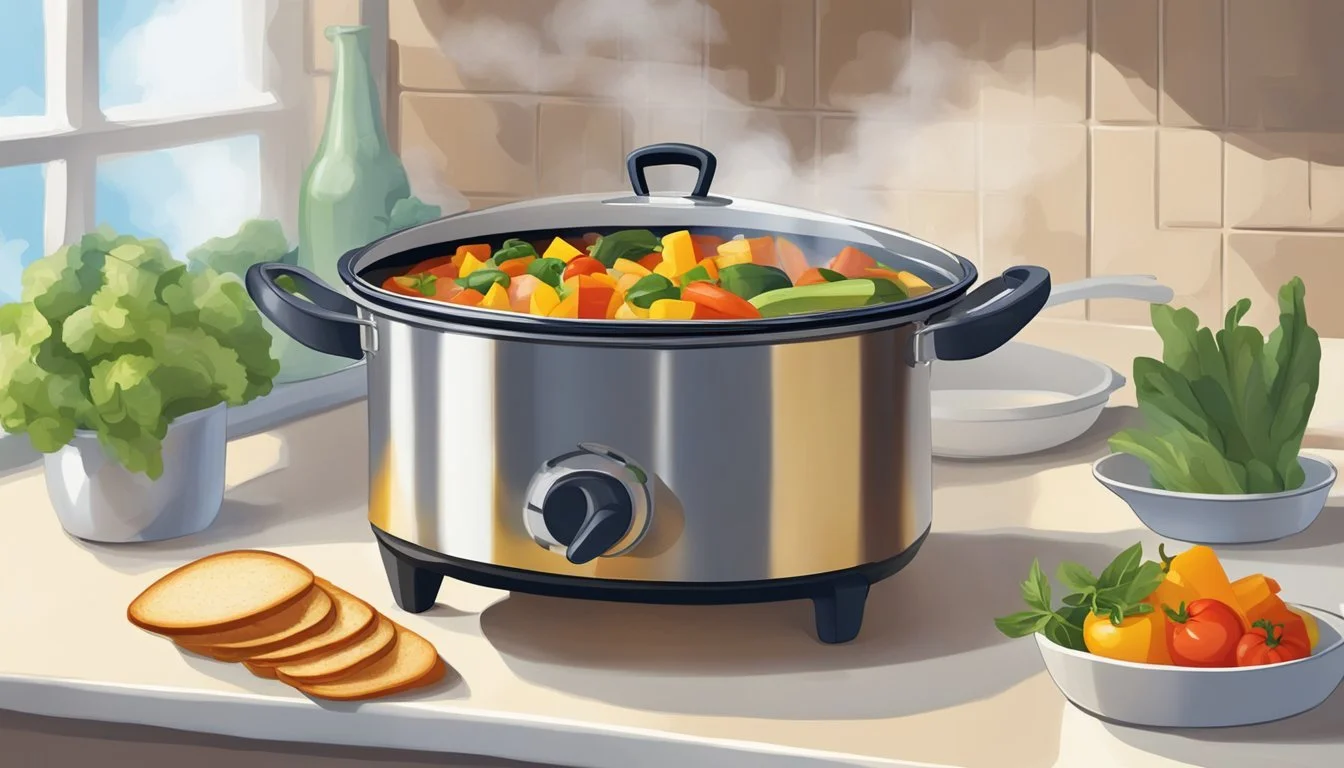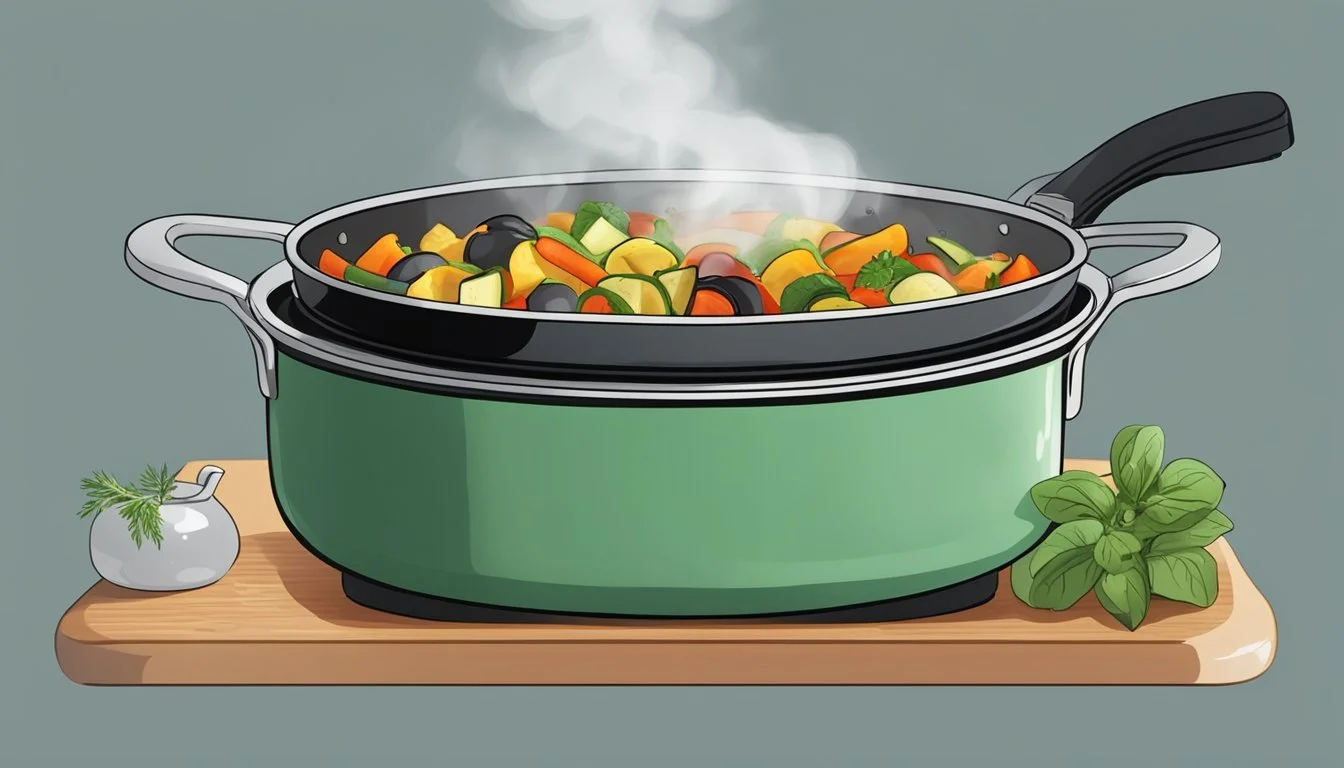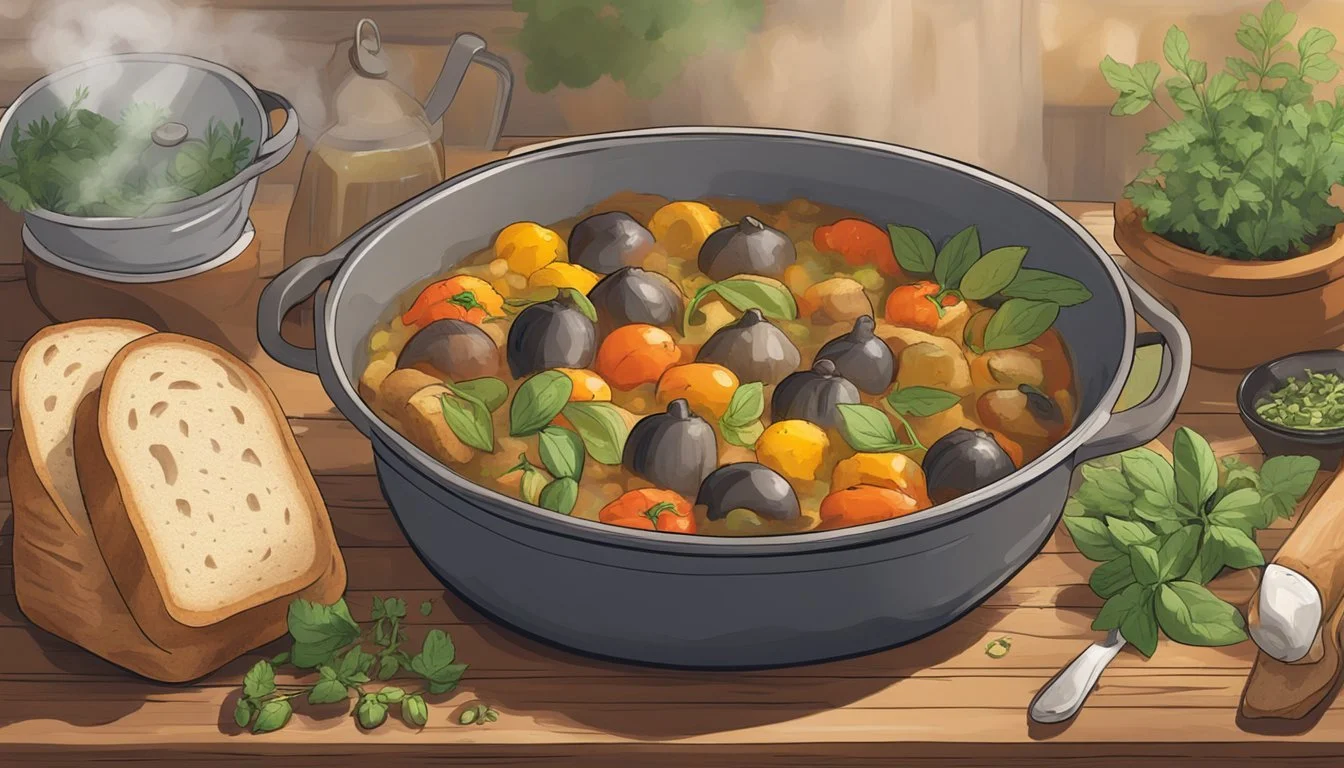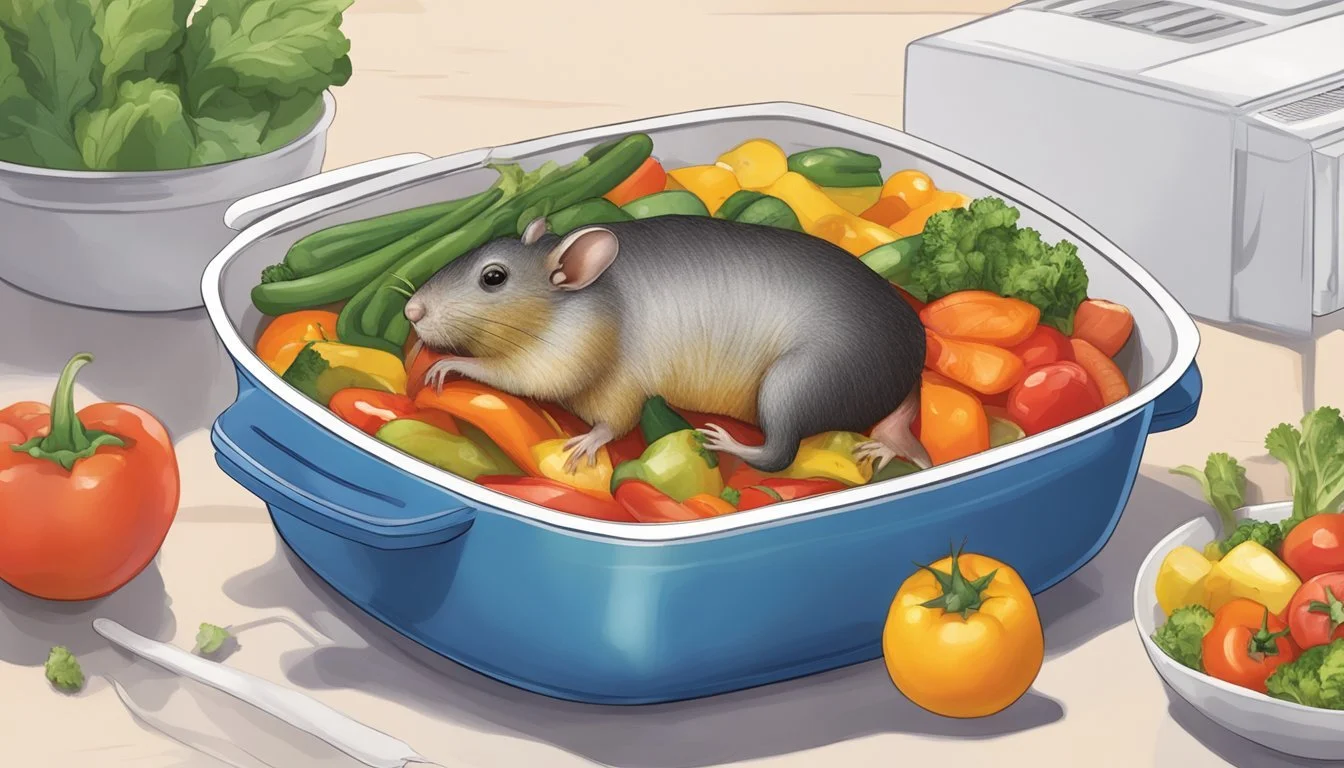Best Way to Reheat a Ratatouille
Tips for Preserving Vegetable Texture
Ratatouille (What wine goes well with ratatouille?) is a classic Provençal stewed vegetable dish that is as vibrant in flavor as it is in color. As with many stews, the flavors in ratatouille can deepen and meld when left to rest, often making leftovers even more delicious than the initial serving. However, the challenge lies in reheating ratatouille without compromising the texture of its constituent vegetables, which include tomatoes, zucchini, eggplant, (What wine goes well with eggplant?) peppers, and onions.
The key to successfully reheating ratatouille is to apply gentle heat that warms the dish throughout without causing the vegetables to become mushy. Care must be taken to ensure that the method chosen not only retains the texture of the vegetables but also preserves the nuanced flavors developed during the initial cooking. Whether opting for the oven or the stovetop, the goal remains the same: to revive the ratatouille to a state that closely resembles its freshly cooked quality.
Maintaining the vegetables' integrity when reheating is essential for the enjoyment of the dish. Techniques such as covering the ratatouille with foil in the oven, or simmering it over low to medium heat on the stovetop, are effective ways to achieve even heat distribution without overcooking. Stirring occasionally can also assist in heating the dish uniformly. The care placed in reheating will ensure that each bite is as inviting as the first, with tender, perfectly warmed vegetables enveloped in the rich, herb-infused tomato sauce.
Understanding Ratatouille
Ratatouille is a classic French dish renowned for its vibrant texture and the quality of its vegetables. It's a celebration of seasonal produce, carefully cooked to perfection.
Components of Ratatouille
The traditional ratatouille is a medley of vegetables such as eggplant, zucchini, tomatoes, and onions, often simmered with garlic and basil. These ingredients form the backbone of the dish, where each vegetable contributes its unique texture and flavor.
Eggplant: Provides a meaty texture.
Zucchini: Adds a soft yet firm bite.
Tomatoes: Offer a juicy and slightly acidic taste.
Onions and Garlic: Bring aromatic depth.
Importance of Texture
The texture is paramount in ratatouille, as the cooking method should preserve the integrity of each vegetable. Overcooking can lead to a mushy dish that loses its appeal, whereas undercooking may result in a dish lacking harmony. It's crucial to maintain a balance where vegetables are tender yet hold their shape for the best eating experience.
Ratatouille Origins
Ratatouille hails from the Provence region of France, its name stemming from the Occitan language. This peasant dish has evolved over time but stays true to its origins by utilizing a bounty of seasonal vegetables. It's a testament to simple cooking that highlights the natural flavors of its components, bound together by the subtle tastes of herbs like basil.
Storage Tips for Ratatouille
Proper storage methods are crucial for maintaining the taste and texture of ratatouille, whether it's for leftovers or advance meal preparation. Implementing the right techniques can help preserve this flavorsome dish while ensuring food safety.
Refrigerator Storage
Storing ratatouille in the refrigerator requires attention to moisture control and container choice. Here are specific tips:
Choose an airtight container: This prevents moisture loss and keeps the ratatouille from absorbing odors.
Refrigeration timeline: Ratatouille maintains quality for 3-5 days when stored properly in the refrigerator. The flavors may improve as the ingredients continue to meld.
Freezing Ratatouille
For those questioning "Can you freeze ratatouille?" the answer is yes. To freeze ratatouille properly involves a few steps:
Cool it first: Bring the ratatouille to room temperature before storing it.
Portion it: Divide into smaller servings if desired for easier thawing.
Airtight packaging: Use freezer bags or containers to keep out moisture and prevent freezer burn.
Label and date: This ensures food safety and quality tracking.
Storage duration: Ratatouille can be frozen for up to 3 months.
Defrosting Techniques
Thawing ratatouille requires gentle methods to maintain quality:
Refrigerator thawing: Transfer the ratatouille to the refrigerator a day before reheating to thaw it slowly.
Avoid room temperature: For safety, do not defrost at room temperature as it can lead to bacterial growth.
Reheating Ratatouille
To preserve the texture and flavor of ratatouille when reheating, proper techniques and considerations are necessary. The method chosen can impact not only the taste but also the texture of the vegetables.
Oven Reheating Method
For the oven method, preheat it to 300°F (150°C). Transferring the ratatouille to an oven-safe dish and covering it with aluminum foil will help maintain moisture. It should be heated for about 15 minutes, but this time may vary based on the portion. Stir the ratatouille occasionally to ensure even heat distribution.
Steps:
Preheat oven to 300°F (150°C)
Place ratatouille in an oven-safe dish
Cover with foil
Heat for 15 minutes
Stir occasionally
Stovetop Reheating Method
They should use a pot on the stove with a lid to reheat the ratatouille over low to medium heat. Keeping the ratatouille covered helps in even heating while stirring occasionally prevents it from sticking to the pot. This should take about 10-15 minutes. One can taste a small spoonful to ensure it's heated through.
Guidelines:
Use a pot and a lid
Reheat on low to medium heat
Simmer for 10-15 minutes
Stir occasionally
Taste to check temperature
Microwave Reheating Tips
When using a microwave, place the ratatouille in a microwave-safe dish. They should cover the dish with a microwave-safe lid or plastic wrap to retain moisture. To avoid cold spots, it is advisable to stir the ratatouille at least once during the reheating process. Short bursts at medium power help in even warming.
Tips:
Use a microwave-safe dish and cover
Reheat at medium power
Stir once halfway through heating
Maintaining Vegetables' Texture
When reheating ratatouille, the texture of vegetables is crucial. To preserve the integrity of the dish, careful temperature management and reheating techniques must be adhered to.
Temperature Control
Controlling the temperature is essential to maintain the vegetables' texture in ratatouille. The oven should be preheated to a moderate temperature of 300°F (150°C) to gently warm the dish without causing the vegetables to become overly soft or mushy. A stovetop approach demands a low to medium heat to avoid aggressive cooking that might compromise the vegetables' structural integrity.
Reheating Techniques
Reheating on the Stovetop:
Simmering: In a non-stick skillet or pot, add a small amount of water or olive oil to create moisture.
Cover with a lid and let the ratatouille simmer for 10-15 minutes.
Stirring occasionally is important to ensure even heating and to maintain texture.
Using the Oven:
Transfer ratatouille to an oven-safe dish and cover with foil.
Reheat at the recommended temperature for about 15 minutes.
Stir a few times during the process to keep the consistency even.
Avoiding Common Mistakes
One should be vigilant not to introduce too much water or oil, which can lead to soggy vegetables. The goal is to retain moisture without altering the vegetables' texture. Also, it is critical not to rush the reheating process; a steamer basket can be used for a gentle warm-up, but avoid high heat that can quickly degrade the quality of the ratatouille.
Enhancing Flavor During Reheating
Reheating ratatouille offers an opportunity to enhance the flavor profile of the vegetable stew. By choosing the right oils and fats, incorporating fresh herbs, and applying seasonings and spices judiciously, one can elevate the taste to closely match that of the freshly cooked dish.
Choice of Oils and Fats
Selecting the appropriate oil or fat is crucial for both reheating and flavor enhancement. Olive oil is a traditional choice that complements the Mediterranean flair of ratatouille. For reheating:
Olive oil: Maintains authenticity; add 1-2 tablespoons while gently reheating to preserve vegetable texture.
Butter: Introduces richness; a small dab can add a velvety finish, but use sparingly to not overpower the vegetables.
Utilizing Fresh Herbs
Fresh herbs can bring a brightness to the dish that may have been muted after refrigeration. They should be added at the end of the reheating process to retain their full aroma.
Basil: Tear fresh basil leaves and sprinkle on top after reheating.
Other herbs: Thyme and parsley also work well; consider a light sprinkle for a fresh, herby note.
Seasoning and Spices
Appropriate seasoning is essential to recover the depth of flavor that ratatouille is known for. Balance is key as to not mask the natural flavor of the vegetables.
Salt and pepper: Reassess and adjust the salt and freshly ground pepper to taste post-reheating.
Garlic: If the ratatouille needs a lift, a small amount of minced garlic can be added while reheating; garlic should be cooked just enough to remove the raw edge.
Seasonings: A pinch of dried spices, such as oregano or rosemary, can also enhance flavor if they were part of the original recipe.
The careful adjustment of oils, fresh herbs, and seasonings can restore and even enhance the ratatouille's flavor during the reheating process, ensuring the dish remains as enjoyable as when it was first prepared.
Serving and Pairing Suggestions
In presenting ratatouille, both the taste and visual appeal are enhanced when complemented by the right sides and beverages. Here is how one might maximize the enjoyment of this dish through thoughtful serving and pairings.
Serving Suggestions
Ratatouille, as a versatile dish, can be served as a main course or a side dish. For a complete meal, one might opt for a portion of whole-grain pasta or crusty bread to accompany the ratatouille, allowing the bread to soak up the flavorful juices.
Cheese offerings, such as a sprinkle of parmesan or a side of vegan cheese, can add a layer of complexity to the ratatouille dish, making it satisfying for both conventional and vegan diets.
Accompaniments and Pairings
Salads: A fresh green salad with a light vinaigrette offers a crisp contrast to the soft texture of the stewed vegetables in ratatouille.
Beverages:
Wine: A medium-bodied red, like a Grenache or Merlot, pairs well with the earthy flavors of ratatouille.
Non-alcoholic: A sparkling water with a twist of lemon can refresh the palate between bites.
For dessert, a light option such as a fruit sorbet or a drizzle of honey over Greek yogurt complements the meal without overwhelming the senses after the rich flavors of the ratatouille.
Nutritional Considerations
Proper reheating techniques can preserve the health benefits and nutritional value of ratatouille. This section will discuss the best methods to maintain the integrity of its nutritious ingredients.
Health Benefits of Ratatouille
Ratatouille is a medley of vegetables, each contributing valuable nutrients to the dish. Here are key vegetables and their nutritional highlights that ratatouille typically includes:
Eggplants: Rich in fiber, antioxidants, and vitamins B1 and B6.
Carrots: High in beta-carotene, vitamin K1, and potassium.
Bell peppers: Excellent source of vitamins A and C, fiber, and folic acid.
Brussels sprouts (though not traditional): Contain high levels of vitamins C and K, fiber, and omega-3 fatty acids.
Retaining Nutritional Value
The way ratatouille is reheated can affect the nutrition of its ingredients. To retain the most nutritional value:
Minimize Heat Exposure: Excessive heat can degrade certain nutrients, such as vitamin C and folate found in bell peppers and other vegetables.
Limit Cooking Time: The shorter the reheating time, the greater the preservation of nutrients. Consider reheating ratatouille just until it is warm to ensure vitamins and minerals remain intact.
By following these recommendations, the nutritional benefits of ratatouille's vegetable components can be retained as much as possible during the reheating process.
Conclusion
In the quest to enjoy a delightful ratatouille with optimal flavor and texture, the reheating method plays a pivotal role. It is the deciding factor between a dish that retains the integrity of its ingredients and one that falls short of expectations.
Final Thoughts on Reheating Ratatouille
The key to successfully reheating ratatouille lies in gentle, even warming. Oven reheating offers an advantage, as it heats the dish throughout without causing the vegetables to become too soft. The process involves:
Preheating the oven to 300°F (150°C).
Transferring ratatouille to an oven-safe dish.
Covering with foil to retain moisture.
Heating for approximately 15 minutes, stirring occasionally.
Alternatively, simmering on the stove is a method that allows for a careful watch over the dish:
Using a pan with a lid to hold in steam.
Keeping the heat low to medium.
Stirring periodically for even heat distribution.
In both cases, it is crucial to:
Avoid overheating, which could further soften the vegetables and spoil the texture.
Stir carefully to maintain the integrity of the vegetables.
Proper storage should not be overlooked, as it plays a significant role in the quality of reheated ratatouille. Here, it’s advisable to:
Cool the dish to room temperature before refrigerating.
Store in airtight containers to preserve freshness.
Convenience often dictates the choice of reheating method; however, prioritizing quality will ensure that the vegetables reheat without losing flavor or texture. Whether opting for the oven or stove, the gentle approach is key to maintaining the ratatouille's vibrant character.







